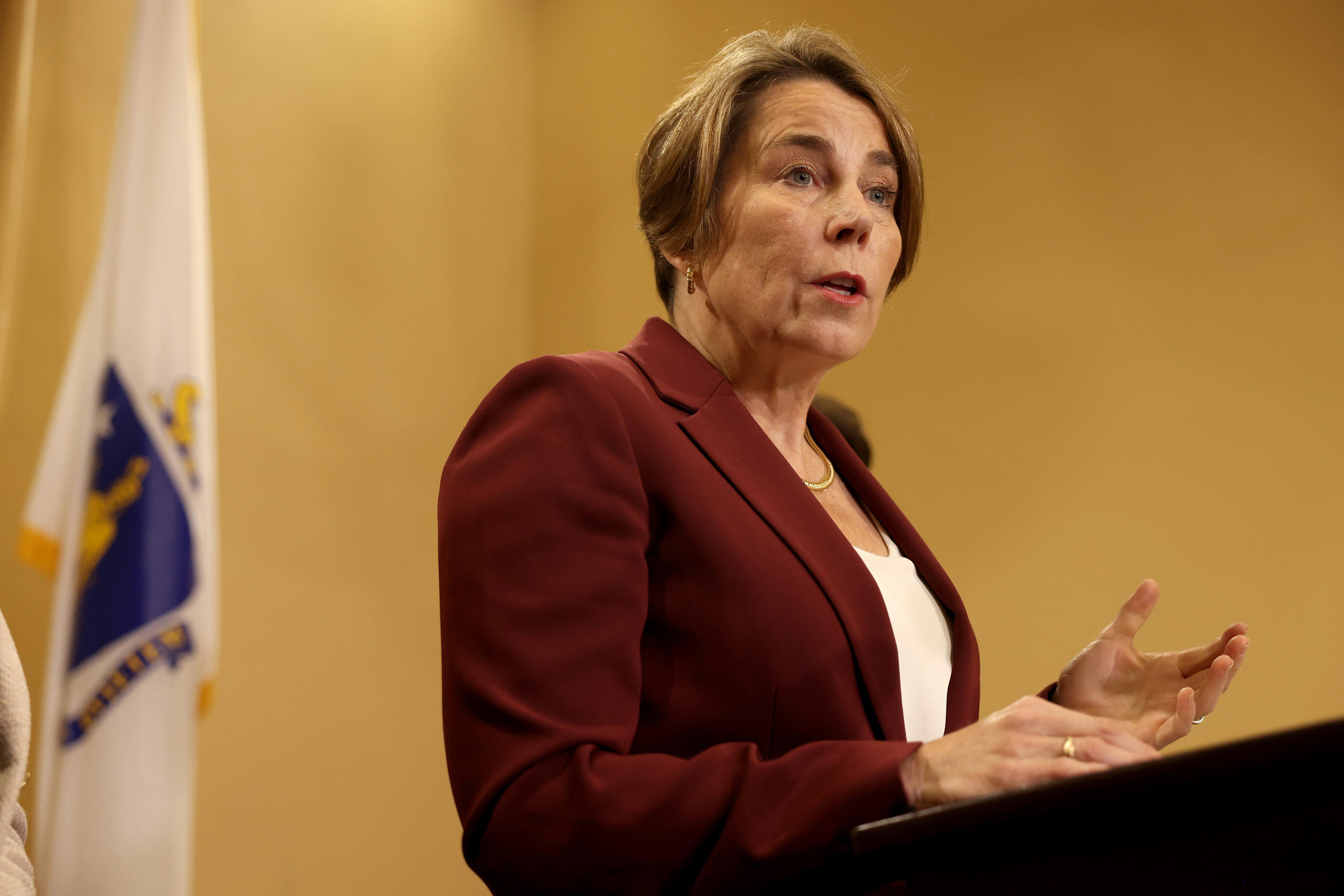Massachusetts isn’t going to gut its landmark climate law—yet.
The state House of Representatives appeared this week to be speeding toward passage of H4744, a bill that would revise some of the programs and policies behind the state’s requirement to halve its emissions by 2030 relative to 1990 levels.
But on Tuesday, House Ways and Means Committee Chair Aaron Michlewitz, a Democrat, said members needed more time to review the bill’s many moving parts. This likely kicks any action into 2026 because lawmakers were to conclude their regular business for the year on Wednesday.
Climate and clean energy advocates expressed relief. They had organized in the few days since the legislation surfaced on Nov. 13 and were lobbying to either kill the bill or add amendments to weaken it.
If the bill had passed in anything resembling its current form, Massachusetts—a national leader on climate policy—would have strengthened the idea that 2025 is a year of fading climate ambitions in the states. Arizona, Connecticut, New York and North Carolina are among the states that have reduced their climate goals or taken other actions that make achieving emissions reductions harder. (I’ll get to specifics in the other states in a moment.)
“We will survive the Trump administration, but we can’t survive having states like Massachusetts bail,” said Larry Chretien, executive director at Green Energy Consumers Alliance, an advocacy group that covers Massachusetts and Rhode Island.
Chretien viewed many parts of the bill as harmful, including a provision that would reduce funding for the Mass Save energy efficiency program by $500 million. He is hopeful that Gov. Maura Healey and the leaders of the House and Senate, all Democrats, can work together in the coming months to find ways to make energy more affordable while maintaining the state’s climate and clean energy policy trajectory.
But the political and economic factors that led to the bill remain. The main sponsor, Rep. Mark Cusack, a Democrat and chair of the committee that oversees energy policy, said the bill was a response to concerns about energy affordability.
Democrats in Massachusetts and across the country want to run in next year’s mid-term elections as the party of affordability and they want to tie Republicans to soaring electricity rates and rising costs of other essentials.
It’s easy for Republicans to blame high electricity costs on the transition away from fossil fuels. This is even though some of the cost concerns are tied to the Trump administration’s budget cuts and the cancellation of grants that helped fund state-level programs.
The complexity of the subject doesn’t lend itself to campaign messages. Power bills are surging due to rising electricity demand from data centers and other large users, increasing natural gas prices and other factors, including spending to support climate and clean energy policies. The significance of each factor varies by state and utility.
Here’s some of what’s happened in other states:
- Arizona: The Arizona Corporation Commission is in the process of repealing the state’s requirement, adopted in 2006, that utilities get 15 percent of their electricity from renewable sources by 2025. On Aug. 14, the commission voted unanimously to direct its staff to continue with the repeal. Commission Chair Kevin Thompson, a Republican, said in a statement that renewable energy technology “should be able to prevail on its own without the need for mandates that have added millions of dollars in extra costs for ratepayers each year.” One wrinkle in this discussion is that Arizona utilities already have met the standard. The debate is mostly about whether it makes sense to have a standard at all, with environmental advocates arguing that a repeal sends the wrong message about the state’s long-term direction.
- Connecticut: On July 1, Gov. Ned Lamont, a Democrat, signed Senate Bill 4, which reduces the state’s targets for its renewable portfolio standard and also allows for wood-burning and other biomass to count toward meeting the standard. The new renewable standard for 2030 requires utilities to get 29 percent of their electricity from renewable sources, down from 40 percent before this change. Lamont said in a statement that “electric bills are too damn high” and described the bill as a first step in addressing a complex issue.
- New York: Unlike other states that are backsliding on climate, New York’s shift has been through a series of small actions rather than a single bill or regulatory order. These actions have left climate and clean energy advocates feeling that Gov. Kathy Hochul, a Democrat, is willing to undermine prior laws and rules that have made the state a leader in climate policy. One example is the Northeast Supply Enhancement gas pipeline, which had been stalled but now appears to be proceeding toward construction, as my colleague Lauren Dalban reported.
- North Carolina: In July, the Republican-controlled legislature overrode the veto of Gov. Josh Stein, a Democrat, of a bill that cancels Duke Energy’s carbon reduction target of 70 percent by 2030 compared to 2005. The bill, which sponsors called “The Power Bill Reduction Act,” has now become law, undoing a key part of a state climate law adopted in 2021, as my colleague Lisa Sorg reported.
Reviewing these examples from states underscores how important Massachusetts is for shaping the national narrative. States tend to follow one another, and certain states, including Massachusetts, play an outsize role because of their history of leadership.
If Massachusetts joins the other states in backsliding, it’s easy to imagine someone in a committee room in, say, Michigan, pointing to Massachusetts and saying it’s long past time for Michigan to follow suit.
Note that I didn’t list Pennsylvania among the states retreating. Gov. Josh Shapiro, a Democrat, reached a budget deal with Republicans in the legislature that says the state will not join the Regional Greenhouse Gas Initiative. But, as ICN’s Pennsylvania reporter, Kiley Bense, reminded me this week, the budget deal isn’t exactly backsliding: The state has never participated in the regional coalition and is not a leader on climate policy.
I don’t want to focus exclusively on states moving backward.
Illinois is an example of a state moving forward with the passage this month of the Clean and Reliable Grid Affordability Act, which expands energy conservation and seeks to increase development of battery energy storage, among many other provisions.
But Illinois is the exception, according to Autumn Proudlove, managing director for policy and markets for the NC Clean Energy Technology Center at North Carolina State University.
“We’ve definitely seen a new trend of states considering legislation that would delay clean energy targets and commitments or remove interim targets,” she said.
Interim targets are important. If a state says it’s going to reach 100 percent carbon-free electricity by 2050, that goal is much more meaningful if there are requirements to meet benchmarks along the way. Failure to meet interim targets can be a wake-up call that policies aren’t working and that lawmakers need to do more.
Or, in this political moment, failure or impending failure to meet interim targets can be an excuse to get rid of them or weaken them. So, Massachusetts, what’s it going to be?
Other stories about the energy transition to take note of this week:
BYD Plans to Double Its Sales Network in Europe Next Year: China-based BYD is making rapid progress in Europe, signaling the company’s status as a global juggernaut in EV sales even though it’s frozen out of the U.S. market because of tariffs. Maria Grazia Davino, BYD’s regional managing director for Europe, said this week that the company will have 1,000 retail locations in Europe by the end of this year and double that total in 2026, as Christoph Steitz reports for Reuters. This news is unsurprising but should also be alarming for Volkswagen and other European automakers that may struggle to hold market share against a rival that can compete on price and quality to the extent that BYD can.
An Ohio County to Hold Referendum to Allow Renewable Energy Development: Richland County, Ohio, which is located about halfway between Cleveland and Columbus, will hold a vote next May in response to a petition from residents who want to overturn local restrictions on wind and solar power development, as Kathiann M. Kowalski reports for Canary Media. The referendum is a rare example of local governments experiencing pushback to bans on renewable energy projects. Ohio could be a wind and solar powerhouse at a time of rising electricity demand, but state and local laws are a major impediment.
St. Paul Project Is a Step Forward for Clean Heat: A development in St. Paul, Minnesota, will tap thermal energy from an aquifer to provide low-cost heating and cooling with no greenhouse gas emissions, as Phil McKenna reports for ICN. The project is called The Heights, and it’s huge, with about 850 homes and several light industrial buildings.
The Sneaky Success of Biden’s EV Charging Plan: The Biden administration helped pass the National Electric Vehicle Infrastructure program, or NEVI, and then faced years of delays in releasing funding to build the promised national network of charging stations. But, as David Ferris reports for Politico, NEVI was a success in at least one important way: It prodded the EV industry to improve the reliability standards of charging stations. The story goes into detail about how charging has improved and how this is part of the backbone of a system to support EV drivers.
Inside Clean Energy is ICN’s weekly bulletin of news and analysis about the energy transition. Send news tips and questions to [email protected].
About This Story
Perhaps you noticed: This story, like all the news we publish, is free to read. That’s because Inside Climate News is a 501c3 nonprofit organization. We do not charge a subscription fee, lock our news behind a paywall, or clutter our website with ads. We make our news on climate and the environment freely available to you and anyone who wants it.
That’s not all. We also share our news for free with scores of other media organizations around the country. Many of them can’t afford to do environmental journalism of their own. We’ve built bureaus from coast to coast to report local stories, collaborate with local newsrooms and co-publish articles so that this vital work is shared as widely as possible.
Two of us launched ICN in 2007. Six years later we earned a Pulitzer Prize for National Reporting, and now we run the oldest and largest dedicated climate newsroom in the nation. We tell the story in all its complexity. We hold polluters accountable. We expose environmental injustice. We debunk misinformation. We scrutinize solutions and inspire action.
Donations from readers like you fund every aspect of what we do. If you don’t already, will you support our ongoing work, our reporting on the biggest crisis facing our planet, and help us reach even more readers in more places?
Please take a moment to make a tax-deductible donation. Every one of them makes a difference.
Thank you,













